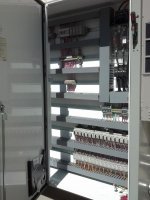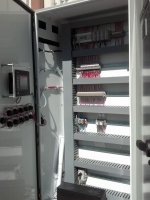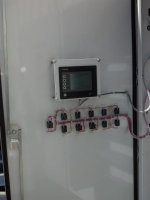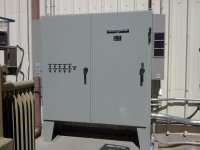I thought that I would add a little update on this project. We're pretty much done. There's a few little things that need to be tidied up, like a 2000 amp main breaker that won't reset, but that really had nothing to do with our work (utility changed the transformer taps. Summertime voltage was +/-520 on a 480 service. Runs 480 in the winter under load.)
We split the controls up into 2 PLCs (MicroLogix 1400). One runs the evaporators (SOVs, starters and return air RTDs ) while the other picks up all the rest (condenser pumps and fans, ammonia recirculator pumps, a coolant recirc pump, plus head pressure, temps (outside and control panel) and humidity (not currently used). The PLCs communicate via ethernet with each other to pass some status information. And we used a Red Lion G306M. The PLCs, HMI and 4-20mA are all backed by a UPS.
We did find a DIN rail mounted 3 position switch to use as an HOA switch.
The A/C units are 6000 BTU IceQube units. There will be a "canopy" built to shade the panel as those units won't even keep up with solar gain during the summer.
I've attached some pictures of the panel after all was said and done. The enclosure interior is 72x72x18. It's a beast and probably could have been smaller. When didn't have a lot of time to really work on the layout before we had to order stuff. The customer wanted room to switch (3) 10HP fans to VFDs. As you can see, the Arizona heat is not kind to Panduit. It's sagging, especially near the top. It was out in the sun for 3-4 weeks before we could get it powered up.
This was a huge learning experience for me and I don't even know who all to thank around here as I read a lot of threads. I know I "borrowed" control for alternating the recirculator pumps (weekly toggle, with failover), analog scaling (4-20mA) and an hour timer snippet.
As I've seen a lot around here, never assume anything. Especially true in a 25-30 year old facility that's been expanded on several times and you hate to open a panel up to see what craziness you'll find inside it. It only reared it's head once but it revealed a big existing problem they didn't know about.
The biggest benefit is having maintenance on your side. They know how the plant runs and how it should run. Sometimes the guys in the office who OK things don't know for sure.











